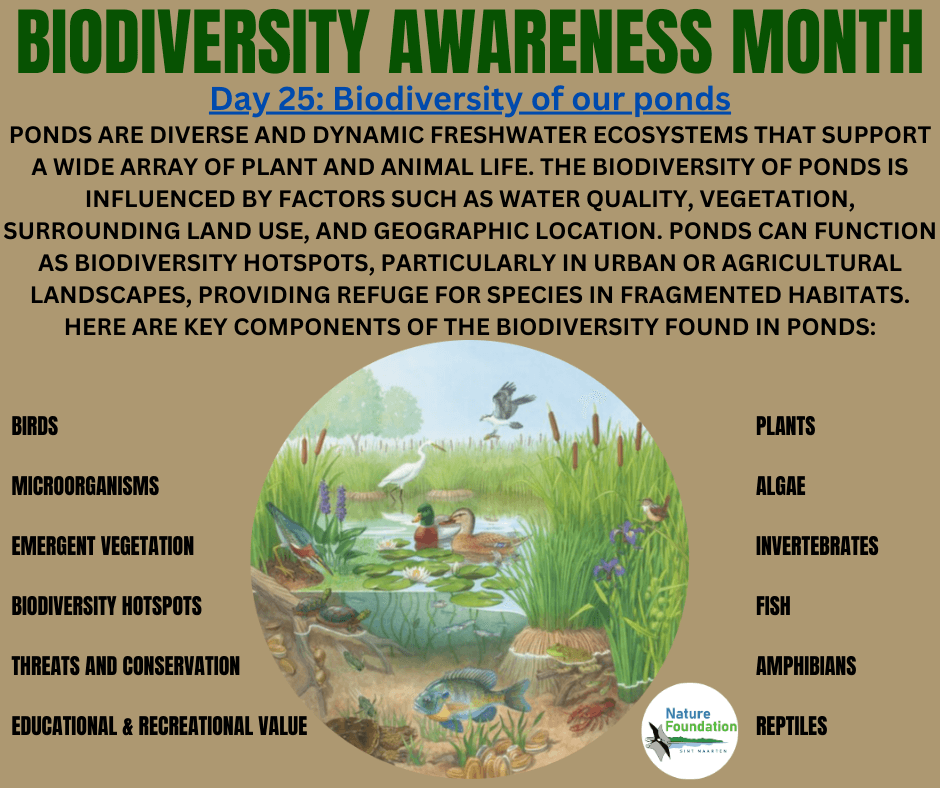Biodiversity month day 25: Biodiversity of our ponds
The St. Maarten Hospitality & Trade Association supports the March Biodiversity awareness month organized by the Nature Foundation in an effort to help protect St. Maartens nature and biodiversity. Todays topic: Biodiversity of our ponds
Ponds are diverse and dynamic freshwater ecosystems that support a wide array of plant and animal life. The biodiversity of ponds is influenced by factors such as water quality, vegetation, surrounding land use, and geographic location. Here are key components of the biodiversity found in ponds:
1. Plants: Submerged Plants: Species like pondweeds and milfoils grow beneath the water’s surface, providing oxygen, habitat, and food for various aquatic organisms.
2. Algae:
Green Algae: Microscopic green algae, such as Spirogyra, often contribute to the primary production in ponds, serving as a food source for various organisms.
Blue-Green Algae: Cyanobacteria, commonly known as blue-green algae, can also be present but may pose risks if they produce toxins.
3. Invertebrates:
Insects: Aquatic insects like dragonflies, damselflies, mosquitoes, and water beetles have various life stages in ponds.
Crustaceans: Crayfish and freshwater shrimp are common in ponds, contributing to nutrient cycling and serving as prey for larger organisms.
4. Fish:
Native Fish Species: Depending on the region, ponds may host native fish species such as tilapia, guppy, and tarp.
5. Amphibians:
Frogs and Toads: Ponds serve as crucial breeding habitats for various frog and toad species. Tadpoles develop in the water before metamorphosing into adults.
6. Reptiles:
Turtles: Ponds provide habitat for various turtle species, which use the water for foraging and basking.
Iguanas: Ponds provide a crucial habitat for iguanas for the vegetation they feed on and the vast aera of water.
7. Birds:
Waterfowl: Ducks, geese, and other waterfowl may visit ponds for feeding and nesting. Wading Birds: Herons and egrets are often attracted to ponds in search of fish and amphibians.
8. Microorganisms:
Bacteria and Protists: Microorganisms play essential roles in nutrient cycling, decomposition, and maintaining water quality in ponds.
9. Emergent Vegetation:
Plants like cattails and bulrushes that grow at the water’s edge provide important habitats for nesting birds and shelter for aquatic organisms.
10. Biodiversity Hotspots:
Ponds can function as biodiversity hotspots, particularly in urban or agricultural landscapes, providing refuge for species in fragmented habitats.
11. Threats and Conservation:
Threats to pond biodiversity include habitat destruction, pollution, invasive species, and climate change. Conservation efforts involve protecting natural ponds, restoring degraded ones, and promoting sustainable pond management practices.
12. Educational and Recreational Value:
Ponds offer educational opportunities for studying aquatic ecosystems and are often valued for recreational activities such as fishing, birdwatching, and nature observation.
Understanding and appreciating the biodiversity of ponds is essential for conserving these dynamic ecosystems and promoting sustainable interactions between human activities and natural environments.
Back to the Visit St Maarten Main page

